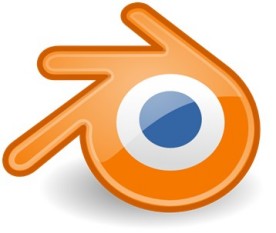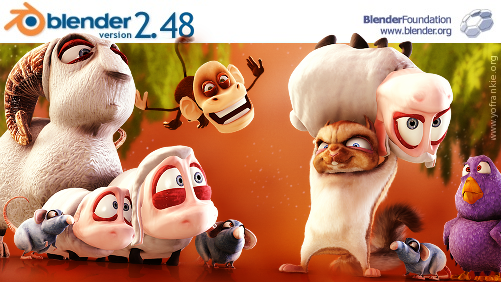On October 15th 2008 Blender foundation released the 2.48 version of this heavenly fantastic software called Blender.
Blender is a free open source 3D software licensed under the GNU General Public License.
 The aim of Blender is to supply the community with a state of the art software for 3D modelling, animation and game design. Blender is strongly developed and can count a vast community supporting it and the huge number of artist around the world who are devoted to it. Blender can moreover compete with hi level, hi quality and hi priced software like 3DS Max, Maya, Cinema 4D, LightWave 3D and so on. I have used it for some time and, even if the GUI it’s not that fashionable and ergonomic as it should perhaps better be, I must admit that the amount of things you can do and the quality you can obtain from it are astonishing. Compared to the other 3D solutions Blender also offers a fully integrated Game Engine.
The aim of Blender is to supply the community with a state of the art software for 3D modelling, animation and game design. Blender is strongly developed and can count a vast community supporting it and the huge number of artist around the world who are devoted to it. Blender can moreover compete with hi level, hi quality and hi priced software like 3DS Max, Maya, Cinema 4D, LightWave 3D and so on. I have used it for some time and, even if the GUI it’s not that fashionable and ergonomic as it should perhaps better be, I must admit that the amount of things you can do and the quality you can obtain from it are astonishing. Compared to the other 3D solutions Blender also offers a fully integrated Game Engine.
One the many things which are simply lovable is the integration with Python which is my favourite programming language.
The new features every release offer are simply brilliant.
See below the list of the improvements in the current version.
– Real-time GLSL Materials
You can get many of Blender’s Materials also drawing in real-time in the 3D window and the game engine, including shadow buffers! It requires a more recent 3D card with good hardware shader support.
– Game Logic
Game logic and game level editing has been improved in many ways. Most notable are the Logic States, which allow to group logic bricks in simple”state engines” and activatate, deactivate, or smoothly make transitions between them.
– Bullet SoftBody
Blender’s GE uses the Bullet physics library. The library has been updated to the latest version, supporting soft body dynamics. Support has been added for flat cloth or volumetric soft bodies. Bullet allows interactions beween soft bodies as well as rigid bodies and static collision bounds of all types.
– Game Engine notes
The Game Engine is back, and better than ever! In this section you can read some of the backgrounds, and a collection of other GE release notes.
– Colored shadows
You can assign an RGB color to any lamp’s shadow now. Although this isn’t a feature supported “in the real world”, it’s a cool trick to allow artists to present a more realistic shading and lighting in their work (without need for GI).
– Shrinkwrap Modifier
As one of the Google summer projects, you can now allow an object to be “shrinked” to match/touch another object’s shape. The modifier works based on vertex groups allowing a part of a model to shrink or be projected
– Grease Pencil
The Grease Pencil allows to sketch annotations, notes and even animated motion suggestions in Blender. Great for collaborated work, remarks from directors or to draw key frame poses for characters.
– Animation tools
A lot of work has been done on better management for inserting keys. Further you can read notes here about rigging, bone locking and aligning. And there’s a Mancandy reference rig update!
– Sun, Sky, Atmosphere
This new “sun/sky” feature allows to use Sun lamps to simulate sky color and atmosphere scattering. A lot of options are available to achieve interesting artistic results, including blend modes and color space.
– Sculpt mode improvements
A couple of new Sculpting options were added. Now brushes allow a custom falloff curve, and there are more options available for textured brushes.
– Python Editor
One of the included Google summer projects was to improve our texteditor with Python IDE features, allowing much more advanced editing and integrated API lookup support for scripters.
– Fluid Control
Fluid simulation can be controlled using particles which define local force fields and are generated automatically from either a physical simulation or a sequence of target shapes. At the same time, as much as possible of the natural fluid motion is preserved.
– Wind & Deflectors
The Wind forcefield now has “noise” option. Force Deflectors now can also occlude or absorb forces.






